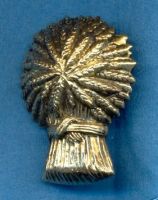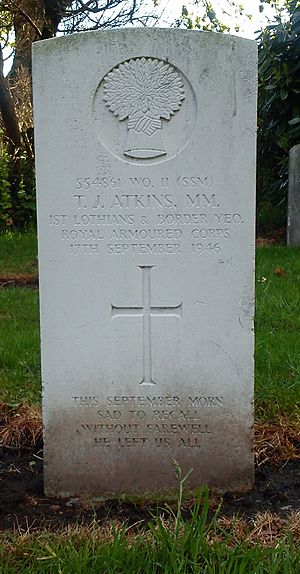Lothians and Border Horse facts for kids
Quick facts for kids The Lothians and Border Horse |
|
|---|---|

Cap Badge of The Lothians and Border Horse
|
|
| Active | 1797–1956 2014–Present |
| Country | |
| Branch | |
| Type | Yeomanry |
| Size | First World War, 3 Regiments Second World War, 2 Regiments Current, 1 Squadron |
| Part of | The Scottish and North Irish Yeomanry |
| Garrison/HQ | Edinburgh |
| Nickname(s) | E (L&BHY) Sqn |
| Engagements | Battle of Normandy Battle of the Scheldt Geilenkirchen salient Rhine crossing Elbe crossing Bou Arada Fondouk El Kourzia Battle of Tunis Liri Valley Arezzo Advance to Florence Gothic Line Argenta Gap |
| Commanders | |
| Honorary Colonel | Donald S.F. Young |
The Lothians and Border Horse was a special type of army unit called a Yeomanry regiment in the British Territorial Army. It was based in the Scottish Lowlands, recruiting soldiers from areas like East Lothian, Midlothian, West Lothian, and near the border with England, especially Berwickshire. In 1956, it joined with other units to form the Queen's Own Lowland Yeomanry.
In 2014, the regiment was re-formed. It became a part of the new Scottish and North Irish Yeomanry, continuing its long history.
History of the Regiment
How the Regiment Started
The Lothians and Border Horse began in 1797. It was first made up of five smaller groups, including the "East Lothian Yeomanry Cavalry." After being disbanded for a while in 1838, it was brought back in 1846. In 1888, it became known as the Lothians and Berwickshire Regiment of Yeomanry Cavalry.
Serving in the Second Boer War
During the Second Boer War (1899-1902) in South Africa, the regiment helped create a company of soldiers called the 19th (Lothians and Berwickshire) Company. These soldiers were part of a larger group called the Imperial Yeomanry. In 1901, the regiment changed its name to the Lothians and Berwickshire Imperial Yeomanry. It was based in Edinburgh at this time. Later, in 1908, it joined the Territorial Force (TF) and was renamed The Lothians and Border Horse (Dragoons).
The First World War (1914-1918)
When the First World War began in 1914, the Lothians and Border Horse was in Edinburgh. Many soldiers volunteered to serve overseas. Because of this, the unit was split into different groups.
One group, the 1/1st Lothians and Border Horse, was divided in 1915. Parts of it joined different army divisions. Later, in 1917, some of these soldiers became infantry (foot soldiers) and were renamed the 17th Battalion Royal Scots. Other parts of the unit, A and D Squadrons, joined together in Macedonia in 1917 and stayed there until the war ended.
Another group, the 2/1st Lothians and Border Horse, was formed for home defense. By 1916, it was in Dunbar. Many of these units were changed into cyclist units in 1916. The regiment moved to Haddington in 1917. Around 1918, this group moved to Ireland, stationed in places like Derry.
Between the World Wars
After the First World War, in 1920, the regiment was reformed. Instead of riding horses, it became an Armoured Car Company. It was first called the 1st (Lothians and Border) Armoured Car Company, Tank Corps. Later, it became the 19th (Lothians and Border) Armoured Car Company, Royal Tank Corps. In 1939, it joined the Royal Armoured Corps.
As another war seemed likely, the Territorial Army grew bigger. The Lothians regiment expanded into two armoured regiments in August 1939: the 1st Lothians and Border Horse and the 2nd Lothians and Border Horse.
The Second World War (1939-1945)
1st Lothians and Border Yeomanry

The 1st Lothians and Border Yeomanry was part of the 51st Highland Division. They were sent to help defend the Maginot Line in France. When the Germans attacked, the regiment tried to join other British forces. They fought the German Army near Abbeville. Outnumbered, they had to retreat for six days to St. Valery-en-Caux. There, they ran out of supplies and surrendered on June 12.
However, some soldiers were able to escape. They helped re-form the 1st Lothians and Border Horse. This new unit joined the 79th Armoured Division. They returned to France on D-Day, June 6, 1944. The regiment stayed in North West Europe until the war ended. They lost 17 men and had many wounded. They also lost several Sherman tanks.
2nd Lothians and Border Horse
The 2nd Lothians and Border Horse was formed in August 1939. In May 1940, it was temporarily assigned to a new unit because there weren't enough Tanks after the retreat from Dunkirk.
In September 1940, the regiment became an armoured unit within the Royal Armoured Corps. They were given Crusader and Valentine tanks. At the end of 1942, the regiment sailed to North Africa for the Tunisian Campaign. After that, they fought in the Italian campaign until the war ended. They fought in many important battles in North Africa and Italy, including Bou Arada, Fondouk, Battle of Tunis, Cassino, and Arezzo.
After the Wars
In 1956, the regiment joined with the Lanarkshire Yeomanry and the Queen's Own Royal Glasgow Yeomanry. Together, they formed the Queen's Own Lowland Yeomanry.
In 2014, the regiment was re-formed as a squadron. It is now called E (The Lothians and Border Horse) Squadron and is part of the new Scottish and North Irish Yeomanry. This squadron is based at Redford Barracks in Edinburgh. On July 10, 2014, the squadron was given the Freedom of East Lothian. This special honor recognized their connection to the county.
Uniforms Through the Years
Before the First World War
Before 1914, the Lothians and Border Horse had a fancy uniform for parades. It included a silver helmet with a white feather, a bright red jacket with dark blue parts, and dark blue trousers with red stripes.
During the Second World War
In 1939, the 1st Lothians unit changed its uniform. They wore the sign of the 48th (T.A.) Division, which was a blue macaw on a red background. Later, they added collar badges. When the 1st Lothians unit was re-formed, they used a greener color for their webbing equipment. They also wore special cloth shoulder titles that said 'LOTHIANS & BORDER YEOMANRY'.
The 2nd Lothians unit also wore French-grey shoulder titles that said 'LOTHIANS & BORDER HORSE'. They also had the sign of the 6th Armoured Division, which was a mailed fist on a black background.
After the Wars
After the war, the uniforms changed again. Soldiers were allowed to wear a collar and tie when off duty. Officers' uniforms returned to an older style with pleated pockets. A dark blue uniform, called No. 1 Dress, was brought back. By 1953, for the Coronation, this No. 1 Dress had changed quite a bit. It showed both the regiment's history with horses and its newer role with machines.
See also
- Imperial Yeomanry
- List of Yeomanry Regiments 1908
- Yeomanry
- Yeomanry order of precedence
- British yeomanry during the First World War
- Second line yeomanry regiments of the British Army

